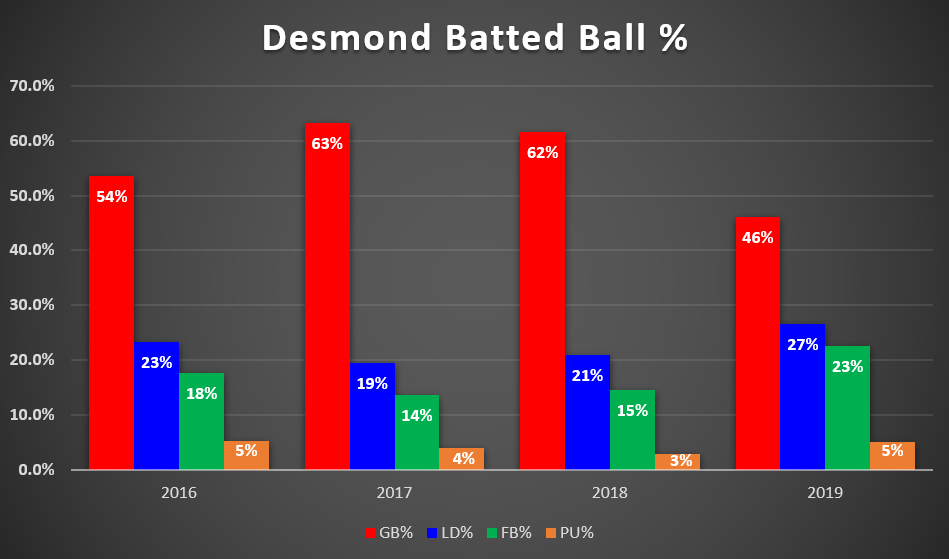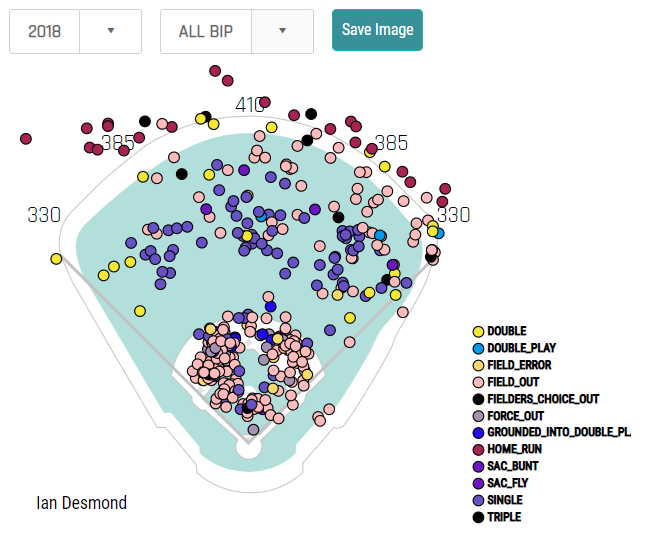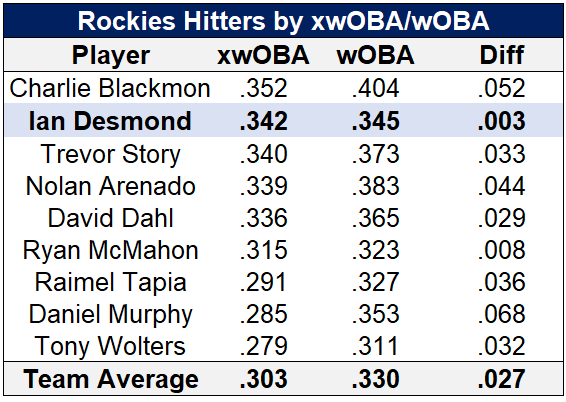Ian Desmond was never my type of fantasy player. For much of his 10-year career, he derived value from compiling counting stats at the top of good lineups. While this made him an intriguing fantasy play, especially from his old shortstop position, it wasn’t backed up by fundamental skill. Desmond’s career ratio stats, which are more indicative of his true production at the plate, measure at a mediocre .264/.316/.427. Moreover, he has only achieved an .800 OPS over a full season once in his career.
Thus, I wasn’t particularly thrilled about the prospects of Desmond heading into 2019, especially after a moribund start to his career in Colorado (69 wRC+ in 2017, 81 in 2018). His Baseball Savant xStats were equally poor, subdued by ground-ball rates north of 60%. 33 years old and on the downswing of his career, Desmond was an afterthought for fantasy owners.
But it turns out that you can teach an old dog new tricks. Desmond’s 2019, buffeted by improvements in his plate approach and an even more favorable Coors Field run environment, has been a renaissance for the Rockies center fielder. His 44 runs, 12 home runs, and 48 RBI in 278 at-bats prorate to 95/25/95 over a full season. In addition, his underlying batted-ball data, highlighted by a 91.8 mph exit velocity and .342 xwOBA, is by far the best of his Statcast career, suggesting even further improvement in his box score production as the season progresses.
Let’s dig into how Desmond engineered this late-career resurgence and why you should be confident owning him in fantasy going forward.
Abandoning the Ground Game
Ian Desmond’s previous calling card was a propensity to drill the ball into the ground, so much so that Desmond’s 58.7% ground-ball rate ranked fourth among 212 qualified hitters from 2016 to 2018. Given that ground balls produce half the offensive value of line drives and roughly one-third that of fly balls, hitting so many worm burners puts a real ceiling on offensive production.
But in 2019 Desmond has cut his ground-ball rate down to 46%, redistributing the savings into significantly more line drives and fly balls. In the process, Desmond increased his average launch angle from 0.0 to 8.3 degrees, the largest year-to-year increase of any player.
The sum of Desmond’s line-drive and fly-ball rates is 50% in 2019, up from 36% in 2018 and 33% in 2017. Over a full season of plate appearances, that amounts to an additional 60 balls hit into the air. That would be a positive change for any player, but it’s an especially valuable one considering Desmond’s home ballpark.
Coors produces a minimal positive impact on ground balls but inflates slugging percentage on line drives by 15% and fly balls by 35%. Sure enough, Desmond accrued zero benefit to the Coors effect through his first two years in Colorado because of his heavy ground-ball inclinations. Desmond’s slugging percentage at home over this span rated at .377 compared with .430 on the road, an exceedingly rare reverse home and away split for a Rockies hitter.
But this year, likely because of his increased affinity for balls in the air, Desmond’s slugging percentage at home is up to .546 while his road performance has also improved to .446.
The Adjustments
In an April interview with The Athletic, Desmond acknowledged that he’s a feel and repetition learner rather than a quantitative one. He exclaimed, “I can’t sit in front of a computer and study. When I feel it, I feel it. And when I don’t, I try to grind until I get it back.”
For Desmond, that grind amounted to an offseason getting acquainted with the Iron Mike, a pitching machine reminiscent of what you’d see at standard batting cages. The difference is that this particular one could gear balls up to 100 mph to Desmond in his backyard. Daily reps on the Iron Mike allowed Desmond to stay better prepared for high-velocity MLB pitching compared with previous offseasons when a friend would casually throw him batting practice.
A better feel for high velocity has allowed Desmond to avoid some of the pitfalls of previous seasons, when he would be consistently late on fastballs. The end result was usually a lightly topped ball to the second baseman or a lazy fly out to right-center field.
Desmond’s improved timing in 2019 has allowed him to catch more pitches at the front of the plate, resulting in significantly more pulled line drives and fly balls. Desmond’s percentage of pulled line drives increased from 4.6% to 8% from 2018 to 2019, while his percentage of pulled flies went up from 1.9% to 5.5%.
It’s evident that Desmond lacked the ability to drive the ball deep to left field in 2018. He’s turned that around this season with an increased incidence of doubles down the line and deep flies to left.
Impressively, Desmond has managed these incremental improvements without selling out for pull power. This is important because hitters who solely focus on pulled fly balls usually sacrifice other aspects of their approach and struggle to improve offensively long-term. Desmond has managed to strike a balance between attacking the right pitches out in front of the plate while maintaining the ability to drive the ball to the opposite field.
Desmond’s 2019 spray chart is very well-balanced, with singles, doubles, and homers scattered uniformly throughout the playing field. This, combined with an ability to hit different pitch types well (displayed by xwOBAs ranging in a narrow band of .339 to .343 on fastballs, breaking balls, and offspeed pitches as well as the eighth-highest exit velocity on breaking pitches), indicates an anti-fragile hitter who is capable of sustaining production.
The Results
Desmond’s improved ability to hit the ball well in the air has resulted in across-the-board improvement in his quality of contact metrics.
His average exit velocity of 91.8 mph and hard-hit rate of 47% are personal Statcast-era highs, and both rank in the 90th percentile of MLB hitters this season. Desmond’s barrel rate of 12% is also a five-year best and ranks in the 75th percentile of hitters this year. These underlying improvements have propelled Desmond’s OPS from .729 last season to .820 in 2019, a showing that ranks as the second-best of his 10-year career. His .496 slugging percentage also ranks as the second-highest of his career, while his .227 ISO is a high watermark.
However, there’s a good reason to believe that Desmond will conclude 2019 with OPS and SLG marks significantly higher than his current showings. That’s because he’s been snakebitten at the plate thus far.
Road Woes
Desmond’s .342 xwOBA is the second-highest among regular Rockies hitters. That’s right—according to xStats, Desmond has been a better hitter than Trevor Story, Nolan Aernado, and David Dahl. However, Desmond’s box score stats lag them significantly.
Rockies hitters as a whole average a +.027 wOBA-xwOBA differential because of the favorable environment of their home ballpark. This is because of the thin Denver air that allows line drives and fly balls to fly farther than their exit velocity and launch angle would predict. Most of the Rockies’ best hitters trend in the +.030 to +.050 range, while Daniel Murphy comes in at an astounding +.068.
However, Desmond is currently tracking at a measly +.003. Why is he not sharing in the wOBA-juicing benefits of his home park?
Well, it actually turns out he is. At home, Desmond’s .375 wOBA is +.049 above his .326 xwOBA. But on the road is a different story, where Desmond’s .311 wOBA trails his .361 xwOBA by -.050.
Colorado hitters tend to experience a road hangover, but it doesn’t manifest in terms of xwOBA underperformance. In fact, the team’s .280 road wOBA exceeds its .269 xwOBA by +.011, indicating that Desmond’s -.050 road offering is the result of poor luck rather than a Coors hangover.
Desmond’s aggressive -.054 BA-xBA differential on the road, to go along with a minimal -.009 ISO-xISO differential, indicates that simple BABIP luck is the main culprit behind his road issues. Expect his road BABIP of .293 to creep up into the .330 range if he can maintain his underlying performance. That should transform Desmond’s current .269 batting average into something closer to .290 and result in increased counting stats.
Headwinds
Desmond’s fantasy value does have some headwinds worth discussing.
For starters, because of the crowded nature of the Rockies outfield, manager Bud Black has been electing to sit Desmond one or two times per week. This has resulted in a lower than expected at-bat count and is frustrating for fantasy owners who might not have another center fielder on their roster.
Fortunately, Desmond’s main competition is Raimel Tapia, a player who has been coming down to earth after a hot start. Tapia’s xStats and fielding in center are a sight for sore eyes, instilling confidence that Desmond will continue to shoulder the majority of at-bats and potentially take over sole possession of center field.
Another issue with Desmond’s game this year is a lack of steals. After being a consistent 15- to 20-stolen base threat for nearly a decade, Desmond has one steal this season in a mere three attempts. Statcast indicates that his sprint speed is still above average, showing that his legs still have it. The issue is likely managerial, as the Rockies’ 34 stolen bases on the year rank 22nd in the majors and significantly trail the pace they’d need to match 2018’s total of 95.
Don’t be surprised if Desmond snags a couple of extra bags in the second half; however, double-digit steals is probably not in the cards this year.
Conclusion
I’ve come around to Desmond. After riding an approach centered on ground balls to mediocre ratio stats and subpar xStats for years, Desmond has completely retooled his approach in 2019, trading weakly hit dribblers for well-hit line drives and fly balls. While these changes have already manifested themselves in an .820 OPS and impressive counting stat production, Desmond has another level to his game.
Keep an eye out for Desmond in the second half as his road batted-ball luck issues subside. He will be someone worth owning during the fantasy home stretch.
Featured image by Justin Paradis (@freshmeatcomm on Twitter)








Would you rather have Desmond or Vogelbach as a bench bat?
I’m going with Desmond! The Coors effect this year is insane and Desmond only stands to improve as positive regression hits. Vogelbach does all of his damage off fastballs and owns a profile that is much easier for pitchers to adapt to.
Desmond does something like this nearly every year. At the point where everyone declares that he is finished he proves that he isn’t. He really has done something like this every year for quite some time. He is just inconsistent but ends up producing in the end. I think you are just laying some batted ball data over the top of what looks like another solid season. I’ll take his 2018 over his 2019 – its at least close so this isn’t really all that significant except from the very narrow perspective of batted ball data. Even in his peak people didn’t really trust him but good players find ways to be good.This seems like a really sabermetric narrative about what Desmond is and has always been, which is relevant one way or another. I think if there is a takeaway here it is on the sabermetric end that GB are very unstable and not the indicator of poor hitting abilities that they are often mistook for. Many problems are real ones, like physical limitations, but hitting GB has a lot of randomness to it and it is very addressable. If trading ground balls for line drives were as easy as talking about taking reps in the offseason I think everyone would do exactly that. More than fixing himself through xEyes, I think xStats are realizing his value this year. Full disclosure, I drafted him a lot this year as he has actual physical talent and some track record but I don’t trust him at all. Age could catch up with him soon and I would never want to have him as my starter but he is a nice upside bench bat. Sprint speed has never had any value in predicting SB, but Desmond seems like he isn’t too interested in running any more which is what matters.